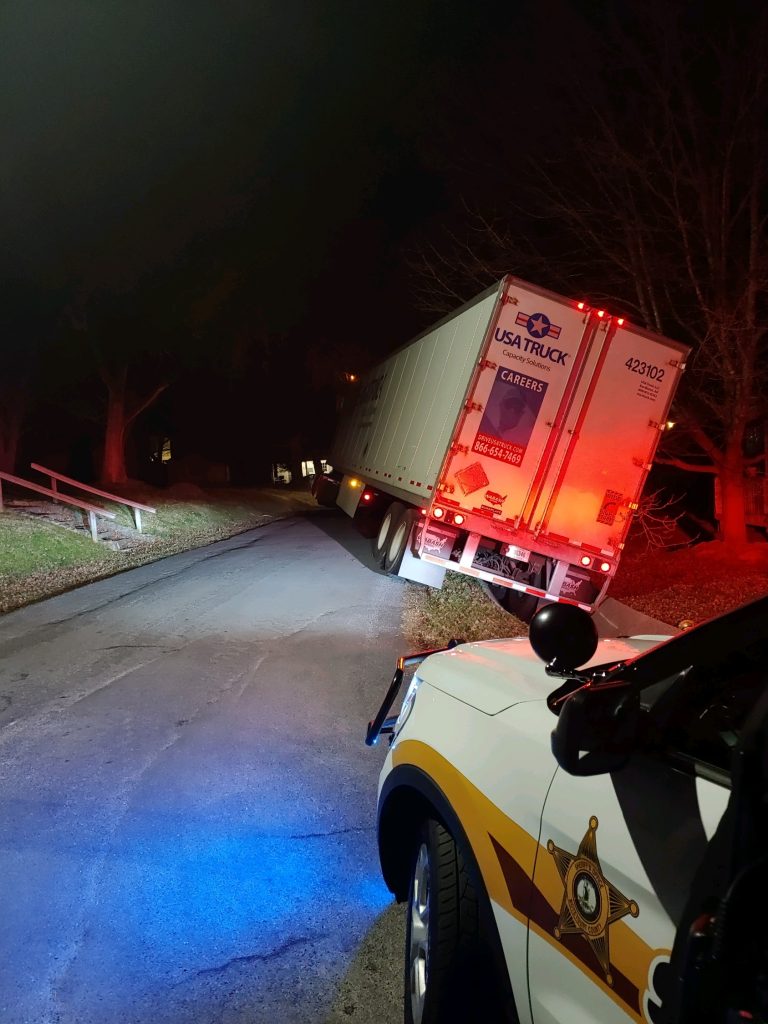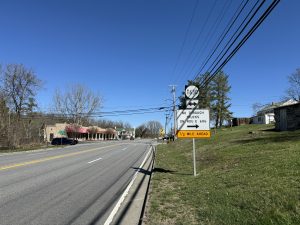
By Matt de Simone
Last month, residents along Murray Street and Water Street in the Town of Fincastle saw an 18-wheeler stuck across from the Early Cabin. This incident is the latest in a long list of instances that saw 18-wheelers making unplanned visits to Botetourt’s historic county seat.
It’s an issue that has persisted for many, many years. The town has made its case to the county about improving the situation as recently as last spring. However, the issue of stuck semis persists while various departments work with the town in coming up with the best solution to better solve the problem.
Fincastle Mayor Mary Bess Smith noted that, in the latest occurrence last month, if there had been a fuel leak from a ruptured tank on the truck wedged along Murray Street and Water Street, it would have contaminated everything downstream from the incident, starting with Big Spring Park, on which the town has spent a lot of time and resources refurbishing over the last few years.
One of the main issues is the lack of signage directly off of surrounding roads. There are currently signs on northbound and southbound Route 220, just before the turn onto Main Street, alerting drivers “no through trucks” on Route 606 (Blue Ridge Turnpike), but none around the Brughs Mill/Farmers Road/Blue Ridge Turnpike intersections, for instance. Additionally, the signs only refer to Route 606, not the small roads within the courthouse district. However, getting that information on the current signs could prove difficult as Fincastle still sits as a throughway for many independent truckers.

Fincastle Planning and Zoning Administrator Scott Critzer believes if there were more signage in areas like the east side of the Brughs Mill/Blue Ridge Turnpike intersection, drivers would have an option to get back on the interstate or take Route 11, if they were aware of the options.
“We’re not asking for some sort of preferential treatment that’s out of line with the preservation of an important historic resource (Fincastle),” Critzer said in a recent interview. “We’ve essentially got a 21st Century world designed to operate on a 19th Century road system and there’s really not much anybody can do to make it better.”
Critzer noted that this issue has gone on “forever,” but said that the problem has grown “significantly worse” in recent years.
Fincastle Town Manager Melanie McFadyen explained that while discussing the issues with the Virginia Department of Transportation (VDOT), they discovered that truckers’ GPS devices may have something to do with the reason why semi-trucks continually find themselves visiting Fincastle for an unexpected period of time. The town worked with VDOT and the Virginia Department of Motor Vehicles (DMV) on finding solutions to ensure GPS devices wouldn’t bring freighters through the town.
“For instance, Munters Group, for a long time, had their GPS set to go through Fincastle,” McFadyen explained. “So, we were able to work with the DMV to change that.”
The town is hopeful to continue discussions with the county, VDOT, and DMW to improve the situation.
According to a VDOT official, Fincastle does not have a through truck restriction in place for Main Street or surrounding roads within it. Those roads are currently considered as “alternate routes for the only through truck restriction on Route 606 due to the one-way road system that was placed in the town.” In 2015, signs were posted on 606 and are present at both ends at Route 220 and Route 11.
Town Council member John Thomas has continued to try to find solutions as well. He’s witnessed (and assisted) drivers maneuvering their trucks out of numerous ruts. Thomas said that these issues have progressed in the last six years.
“Since 2018, we’ve had about 36 incidents where deputies have been called for their services to assist trucks,” Thomas said. “The fire hydrant at Main Street and Springwood Road (intersection) had three service calls… and eventually had to be moved because it was getting hit by tractor-trailers. My whole thing is, the streets in the town are not conducive to 18-wheelers whatsoever, no matter what street it goes in because there’s nowhere for them to exit properly.”
Out of the 36 instances mentioned by Thomas, 18 were recorded incidents by the Botetourt County Sheriff’s Office involving semi-trucks getting stuck in Fincastle. In over half of the recorded instances, trucks wound up stuck on the north and south sides of Hancock Street. According to a town official, there have been more instances that weren’t reported to authorities where drivers received assistance from residents in maneuvering the vehicle out of predicaments. Thomas wants a “no through” sign on every entrance in town.
“The roads not capable of handling 18-wheelers,” Thomas continued. “If (local businesses/schools) have box trucks that have to (drive into town to) make a delivery, that’s okay. Our main purpose is to not have 18-wheelers enter the town off of those side streets.”
Last summer, a semi-truck jammed itself along the intersection of Main and Hancock. According to a town official, it took several hours and a group of Sheriff’s Office deputies to assist getting the truck unstuck. One of the town’s decorative lights and a couple of signs were damaged during this specific incident.
Other instances have seen trucks damage the lawns of residents, knocking down signs, damaging fire hydrants, and causing residents to leave their homes in order to direct the drivers out of their predicaments and/or navigate traffic around the stuck semi.
One issue with large tractor-trailers driving through Fincastle is that some drivers’ destinations are made for deliveries, which is something that VDOT can’t prevent.
“A through truck restriction is not a ban on all trucks as it only pertains to through trucks, not deliveries,” a VDOT official recently explained. “When VDOT last took traffic counts in 2014 in the town, there was truck traffic present on routes in the town, but there would not be viable alternative routes if these roads in the town were restricted. At the time of the study VDOT performed, there were deliveries to the schools and the school administration building, for example.”
Independent trucking companies aren’t on the same grid as the major entities and aren’t on the same “route” as freighters from Munters and similar corporations locally. Large truck deliveries are needed by businesses and schools in the Fincastle area. Deliveries are one of a few reasons that Fincastle wouldn’t be allowed to shut off 18-wheeler traffic.
“People still expect deliveries,” Sheriff’s Office Deputy David Moyer said in a recent phone interview. “Those types of (trucks) are allowed to access and go truck route. (That “no through” signage) doesn’t forbid certain size trucks altogether.”

Graphic courtesy of Town of Fincastle
However, the town has put together solutions in the past. In particular, the “Springwood Road Extension Plan” developed by town management nearly 20 years ago.
Last spring, the town submitted a request to the county related to a potential extension project to better mitigate “big truck” traffic. At the April 25, 2024 meeting of the Botetourt County Board of Supervisors, Mayor Smith and former Town Manager David Tickner gave a brief presentation about a potential Springwood extension.
The project was initially a part of the county’s six-year plan around 2006, but was taken off in 2007. During the presentation, the Fincastle representatives shared with the board that there is currently only one way through town for all traffic going to the school complexes and outgoing traffic on Springwood Road to Wheatland Road and on to the Town of Buchanan, as well as out to the Blue Ridge Turnpike (Route 606). Roughly 60 percent of the right of way has already been dedicated, the presentation went on to explain. The addition of the roadway could open up development opportunities for several properties in the area that are not currently served by public roads.
The Springwood Road Extension would connect Route 220, a little south of the Quickette Food Mart, running along an approximate 3/4-mile stretch, and connecting with the intersection of Springwood Road and Poor Farm Road.
Another route would be considering an outright restriction on 18-wheelers winding their way through town. That request would require involvement from Botetourt County, which would then eventually fall into the responsibility of local law enforcement to enforce the restriction.
“To request a through truck restriction, a county must pass a resolution asking VDOT to study and consider one,” the VDOT official went on to explain. “However, the resolution must identify a viable alternative route using roads that are comparable to the road where the restriction would be in place. In this case, Main Street would be the alternative route for Route 606 (Blue Ridge Turnpike).
“As part of the resolution, the county commits to enforce the restriction which becomes the responsibility of local police if it is implemented. If VDOT supports the restriction, the county also holds a public hearing before it is finalized, and signs are put in place to provide adequate guidance to the trucking industry and assist enforcement of the restriction.”
The Sheriff’s Office continues to work with the town to figure out how to better handle trucks getting stuck along Hancock, Water, and other streets. When asked about the issue, Botetourt County Sheriff Matt Ward noted that they’re still in the “initial stages” of the solution process.
“We recently shared data with Town Council that showed we responded to 18 calls for service in the last five years where oversized loads and trucks frequently obstructed town streets, caused damage to personal and government property, or would become immobilized due to the narrow streets within the town limits causing frustration among residents,” Ward explained in a recent statement about the stuck trucks in town. “Those calls varied in duration and severity, and a few resulted in some minor damage to property.
“I have been told, in the future, the town will be inviting us to a meeting with our partners at VDOT to talk about possible solutions. Ultimately, VDOT is the designated authority of our highway transportation system. Our responsibility is to ensure the safest possible traffic environment through enforcement of established laws and collaborative efforts with VDOT. Traffic safety is a priority and we look forward to working on solutions that will reinforce safe driving behaviors and prevent property damage.”
The town is hopeful that continuing discussions with the county, VDOT, and DMW will result in a solution for this ongoing problem sooner than later. Fincastle Town Council meets this Thursday, March 14, at the Fincastle Volunteer Fire Department Training Room at 7 p.m.




